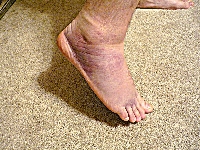
Common Ankle Injuries
You are carefully walking down the street, minding your own business, when, boom! You’ve stepped on a crack and broken your back. Actually, you have stepped in a hole and managed to twist your ankle. It hurts like crazy!
What are some of the common ankle injuries and how to you repair them?
Emergency room docs see this all the time. A patient comes hobbling in after twisting his ankle, which is swollen to twice its original size and has turned purple. Next up, ankle wraps, supports and weeks of tender care.
The most frequent injuries involve fracture and sprains. A fracture occurs when a bone breaks. A sprain happens when ligaments are damaged, which occurs when they are stretched beyond normal range.
~
The majority of ankle mishaps take place during athletic activities, but that does not preclude the “walking down the street and stepping onto an uneven surface” scenario, which can do equal damage.
Other parts, including cartilage and tendons, can be harmed. Cartilage cushions joints and tendons connect bone to muscle. The tendons most often hurt are the peroneal tendons, which protect and stabilize the ankle which when injured or overworked causes tendons to become inflamed. This is referred to as tendinitis.
Tendons can tear. If repeatedly torn, this leads to tendinosis.
Additionally, tendons can slip out of place (subluxation) or rupture.
Sometimes the ankle rolls, which makes the ligaments stretch way beyond their typical length. Ligaments can tear if the rolling force is powerful. You may hear a popping noise when rolling takes place.
Athletes frequently sustain liagmentous injuries particularly when participating in sports that require jumping. This injury is often recurrent.
When suffering from an injury of this nature, the patient can generally point to the precise spot where he hurts. This indicates to the doctor which ligament has been harmed.
When injury takes place, swelling occurs. The amount of swelling shows the degree of seriousness. Damage leads to edema (swelling) and to blood surrounding, and in, the joint. This causes problems because it limits the joint’s range of motion.
What do you do?
The first course of action is RICE (rest, ice, compression, elevation.) The injured person is generally advised not to put his full weight on the foot. The ankle is taped and sometimes braced.
Avoid applying heat to the injury because this encourage blood flow, which leads to swelling. When swelling and pain are reduced this prevents muscle inhibition around the joint, which is good.
When a fracture occurs, the ankle is immobilized and the individual may have to use crutches. Some are put in a below-the-knee cast that is worn for six weeks.
Take preemptive action
Before engaging in any athletic activity, take the time to stretch. This warms up muscles. When a joint isn’t flexible this leads to injury. Warming up increases flexibility in joints.
If you just started an exercise regimen, do not go hold wild the first day out. Gradually build your speed (when running) and duration. Preceding slowly allows the muscles to develop mobility and strength.
Runners typically injure the ligaments located on the inside and outside of the ankle. If the runner doesn’t take time off after sustaining an injury, the repeat pounding of the foot on hard surfaces can weaken bones to the point that they break.
Those having extremely high or low arches in their feet are more inclined to sprain ankles. Wearing orthotics may prevent this.
Having good balance also lowers the risk of an injury because the person doesn’t put the joint in a position that leads to damage.
Wearing supportive shoes safeguards feet and ankles. If you know you have weak ankles, tape or brace them to avoid another injury.

